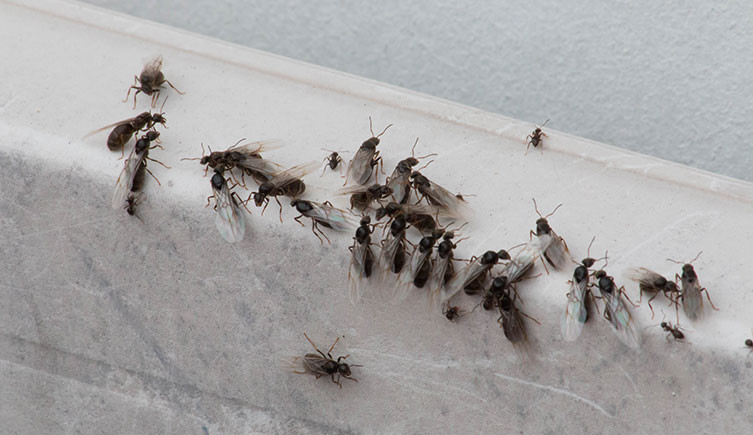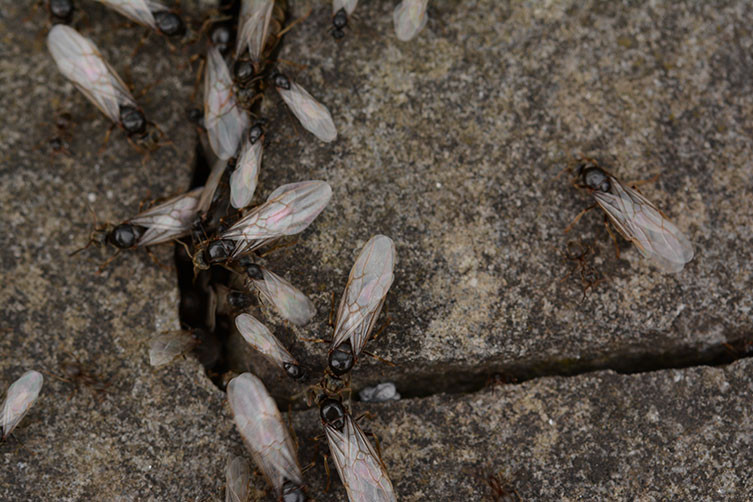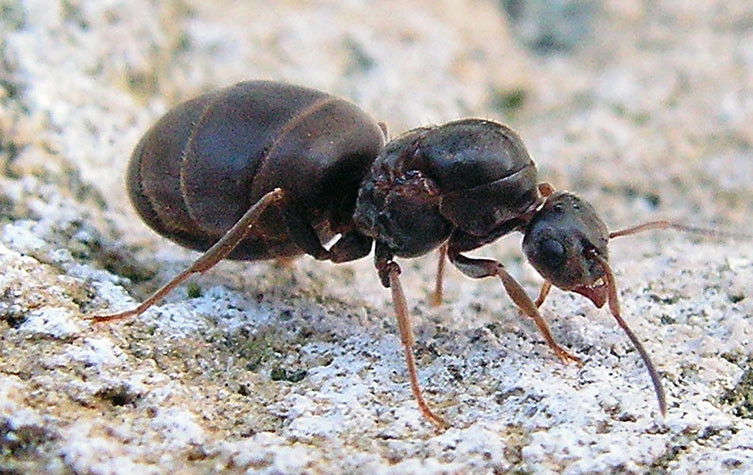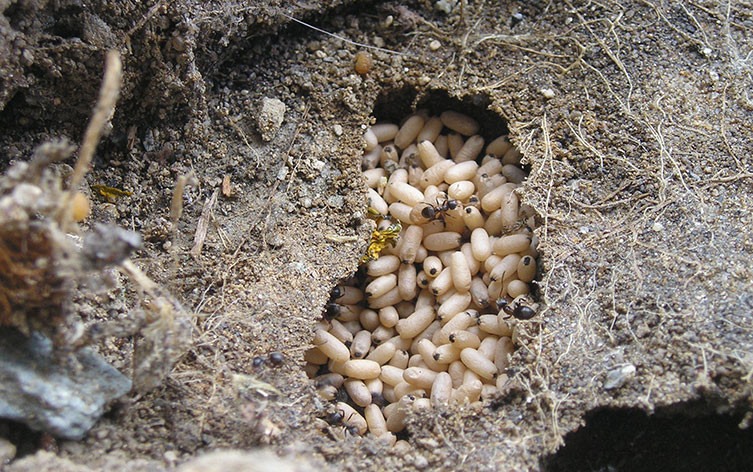Do ants fly? Yes, certain ants, specifically the queens and males (drones), do fly during what’s known as their nuptial flight, a crucial event for reproduction and colony establishment. Flyermedia.net helps you understand the fascinating world of flying ants. This swarming behavior is triggered by specific weather conditions and plays a vital role in both the ant life cycle and the broader ecosystem.
Ready to explore the skies? Discover how ants take flight, the science behind swarming, and why these winged creatures are more beneficial than bothersome with Flyermedia.net!
1. What Exactly Are Flying Ants, and Why Do They Have Wings?
Flying ants are technically known as alates, which are sexually mature queens and male ants. They are unique from worker ants, as they have wings. Black garden ants (Lasius niger) are most commonly seen in urban areas in the United Kingdom. The queens are much larger, reaching lengths of up to 15mm.
Why do ants have wings?
Winged ants are sexually mature queens and males. According to the Royal Entomological Society, the wings enable them to participate in the nuptial flight, a critical stage for mating and establishing new colonies. The wings ensure queens can travel far from their birth colony to start new colonies.
2. When Does Flying Ant Day Typically Occur?
Flying ant day doesn’t really happen, but flying ant season does. It usually occurs in July or August, often coinciding with hot, humid weather. However, this emergence isn’t confined to a single day.
Does Flying ant day happen at the same time everywhere?
The Royal Society of Biology disproved the idea of flying ant day. It varies depending on geographical location and climate. Urban areas tend to experience these swarms earlier than rural areas due to the urban heat island effect. A multi-year citizen science project found that winged ants emerge over several weeks, with peaks lasting a few days each.
 Winged ants on a building
Winged ants on a building
The “Flying ant day” myth is a misconception. The swarming of ants lasts for weeks.
3. Where Do Flying Ants Originate?
Flying ants emerge from established colonies, typically nesting in dry soil found in flower beds, lawns, and under paving stones.
Where do flying ants live?
They thrive in sunny, dry locations, including gardens, pavements, and even brownfield sites. Before swarming, you might notice mounds of soil appearing near these nests, indicating the preparation for the alates’ departure. These mounds of soil shows that a colony is coming to life and preparing to spread.
4. Why Do Ants Engage in Flight?
Ants fly in order to mate and establish new colonies. The nuptial flight allows the queens to mate and find a suitable place to start a new colony.
What do the flying ants do when in flight?
The nuptial flight is a crucial part of ant reproduction. During this flight, queens mate with several males, ensuring they have enough sperm to fertilize eggs for the rest of their lives. This event is vital for the continuation and expansion of ant populations.
5. What is the Purpose of Ant Swarming?
Ants swarm to protect themselves from predators and increase their chances of reproduction.
Why do ants swarm in large numbers?
According to research from the University of Bristol, swarming provides protection through sheer numbers, overwhelming predators and increasing the likelihood of successful mating encounters. The mass emergence ensures that more ants survive to reproduce and establish new colonies.
 Winged ants about to fly
Winged ants about to fly
Flying ant season provides a feast for many animals, including gulls. Image courtesy of Pixabay (CC0).
6. What Transpires After the Nuptial Flight?
After mating, male ants die, and the queens shed their wings and seek a nesting site to establish a new colony.
What do the males do after the nuptial flight?
The mated queens, now without their wings, prioritize finding a suitable location to dig a chamber and begin laying eggs. Discarded wings are a common sight after a swarming event.
What do the queens do after they shed their wings?
The sperm that the queen received during the nuptial flight will enable her to lay fertilised eggs for the rest of her lifetime. The queen will remain in this chamber, not eating for weeks, until her first brood of worker ants are ready to forage for food.
7. How Long Do Flying Ants Typically Live?
Male flying ants typically live only a few days after the nuptial flight, while queens can live for many years.
How long do males live for?
The males’ sole purpose is to mate. They develop from unfertilized eggs. After the nuptial flight, the male ants usually only live for another day or two, so not much more than a week in total. Their sole reason for existence is to mate with new queens.
How long do female queens live for?
Lasius niger queens can generally live for up to 15 years. They spend most of their lives in their nest. They only spend a small portion of their lives as winged or flying ants.
8. Why Are Flying Ants Actually Beneficial?
Flying ants improve soil quality through their tunneling activities and serve as a vital food source for birds.
How do flying ants help birds?
During the swarming events, birds like swifts and gulls feed frenziedly on the rising swarms of ants.
How do flying ants improve soil quality?
They can provide benefits to the soil through their tunnelling activities. This can improve soil quality, creating tiny air pockets that bring oxygen to plant roots.
9. Which Ant Species in the UK Exhibit Flight?
While the black garden ant is the most commonly observed, other species like the red ant (Myrmica rubra) also participate in nuptial flights.
Which ants are most commonly observed flying?
According to the Royal Society of Biology, nearly 90% of winged ants observed were black garden ants. The types of ant you see flying will depend on where you are. For example, in woodland you may see wood ants. All ants require good weather to fly, with no rain or wind.
 A queen ant that no longer has wings
A queen ant that no longer has wings
This Lasius niger queen has chewed off her wings after mating
10. What Weather Conditions Trigger Flying Ant Swarms?
Warm, calm weather conditions are most conducive to flying ant swarms.
What is the temperature and humidity to trigger swarming?
The temperature and humidity that triggers swarming and flight is different for each species, so the timings of their nuptial flights will vary. According to a study in Ecological Entomology, ants only flew on days when it was warm, not windy, and conditions had improved compared to the previous day.
11. How Can I Manage Flying Ants Around My Home?
While generally harmless, if flying ants become a nuisance, you can use natural deterrents like peppermint oil or vinegar solutions.
Are flying ants harmful?
Flying ants are generally harmless. Their presence is a natural phenomenon and they don’t pose a significant threat to property or health.
What are some natural deterrents?
Peppermint oil or vinegar solutions can keep the ants away from your home.
12. What Role Do Ants Play in the Ecosystem?
Ants contribute to the ecosystem by improving soil aeration, dispersing seeds, and preying on other insects.
Do ants prey on other insects?
Ants are predators to many insects, keeping populations balanced and contributing to the overall health of the environment.
Do ants help with seed dispersal?
Ants help to disperse seeds by carrying them to their nests, aiding in plant propagation and maintaining biodiversity.
13. How Do Ants Protect Themselves from Predators During Flight?
Swarming in large numbers overwhelms predators, increasing the survival rate of individual ants during the nuptial flight.
Which predators are most common to ants?
Birds, spiders, and other insects feed on flying ants. The sheer volume of ants during a swarm helps to ensure that at least some survive.
How does the swarming tactic help?
The swarming tactic overwhelms predators and ensures survival of the species. Safety in numbers.
14. Are Flying Ants a Sign of a Healthy Ecosystem?
Yes, the presence of flying ants indicates a healthy, balanced ecosystem.
What does the presence of flying ants indicate?
Their activity supports various ecological processes. They are a natural part of the environment. The presence of flying ants signifies that the ecosystem is functioning correctly.
How can ant activity be eco-friendly?
Ants help to aerate the soil, disperse seeds, and serve as a food source for other animals, supporting overall biodiversity.
15. How Do Ants Communicate with Each Other to Coordinate Swarming?
Ants communicate through pheromones, chemical signals that help coordinate their behavior during swarming.
What are pheromones?
Pheromones are chemical signals that ants use to communicate with each other.
How do they work?
These signals help to synchronize their flight patterns and ensure that they swarm at the same time. According to research from the University of Copenhagen, pheromones play a key role in the coordination of ant swarms, ensuring that the ants emerge simultaneously for mating.
16. What Is the Lifespan of a Worker Ant?
Worker ants typically live for a few months to a year, depending on the species and environmental conditions.
What factors influence the lifespan of worker ants?
The lifespan of worker ants depends on species and environmental conditions.
How long do ants live for in general?
Different species of ants have varied lifespans, influenced by factors such as food availability, climate, and overall colony health.
17. How Do Ants Choose a Nesting Site for a New Colony?
Queens select nesting sites based on factors like soil moisture, temperature, and proximity to food sources.
What is the ideal nesting site for ants?
Ideal nesting sites provide protection from predators and favorable conditions for raising their young. The nesting location ensures the survival and growth of the new colony.
What steps do the ants take to prep the site?
Queens dig underground chambers and prepare the site before laying their first eggs.
18. Can Flying Ants Damage My Garden?
Flying ants themselves do not directly damage gardens, but their nesting activities can sometimes disturb plant roots.
What effects do ants have on plants?
Nesting activities can sometimes disturb plant roots, but the tunneling also aerates the soil.
How do plants benefit?
Improved soil aeration benefits plants, making ant activity a double-edged sword for gardens.
19. Do Flying Ants Bite or Sting?
Flying ants, like other ants, can bite, but they are not aggressive and rarely pose a threat to humans.
Do flying ants sting?
Flying ants can bite, but they are not aggressive and rarely pose a threat to humans.
Are their bites dangerous?
Their bites are generally harmless and do not cause significant pain or irritation.
20. What Is the Difference Between Flying Ants and Termites?
Flying ants have a narrow waist, bent antennae, and unequal wing sizes, while termites have a broad waist, straight antennae, and equal wing sizes.
How can you tell the difference?
These distinct physical traits help differentiate them. Knowing the differences is crucial for pest control and understanding their ecological roles.
Do these differences mean anything?
These differences reflect their different roles and behaviors in the ecosystem.
Understanding the phenomenon of flying ants can turn a moment of annoyance into a fascinating learning experience. Are you curious to learn more about the insects in your backyard? Visit Flyermedia.net for more articles.
Ready to take your understanding of the skies to new heights? At Flyermedia.net, you can delve into pilot training programs, aviation news, and exciting career paths in aviation. Whether you’re an aspiring pilot, aviation enthusiast, or simply curious about the world of flight, we’ve got you covered.
Address: 600 S Clyde Morris Blvd, Daytona Beach, FL 32114, United States
Phone: +1 (386) 226-6000
Website: flyermedia.net
FAQ about Flying Ants
- Do all ants fly?
No, only the queens and males (drones) fly during the nuptial flight. - Are flying ants harmful to humans?
No, they are generally harmless and rarely bite or sting. - What is the purpose of flying ant day?
It’s a coordinated swarming event for mating and establishing new colonies. - How long do flying ants live?
Males live a few days after mating, while queens can live for many years. - Why do ants swarm in large numbers?
To protect themselves from predators and increase mating opportunities. - Are flying ants the same as termites?
No, they have distinct physical differences. - What weather conditions trigger flying ant swarms?
Warm, calm weather. - Do flying ants damage gardens?
Not directly, but nesting activities can sometimes disturb plant roots. - How do ants communicate during swarming?
Through pheromones. - Are flying ants beneficial to the environment?
Yes, they improve soil quality and serve as a food source for birds.
 Exposed ant nest
Exposed ant nest
A Lasius niger ant nest that has been exposed when a paving slab was moved.
